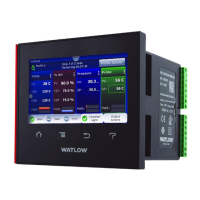Watlow F4T • 201 • Chapter 5 Function Reference
Transmitter Active Level
Set the state of the output that indicates the input has been active for at least the specified
time.
Options:
• High: On
• Low: Off
Elapsed Time
Indicates the amount of time since the input became active up to the value set with the Time
parameter, then holds at that value until the input becomes inactive. When the input be-
comes inactive, Elapsed Time is reset to zero.
Range: 0 to 99,999.000
Note:
The elapsed time is not retained through a power loss; it is set to zero upon power up.
One Shot
The One Shot timer behaves like an analog oven timer. The user sets the time and the timer
counts down to zero without retaining the original time (hence the name one-shot). The out-
put is active whenever the time is greater than zero, and the timer counts down while the in-
put is active until the time reaches zero. This can be used in applications where the user may
set a different time each time the process runs.
To understand the timer’s behavior, consider these scenarios illustrated in the timing diagram
below:
1. If the input is active when the time is set by the user, the output becomes active and the
timer starts counting down immediately. The Time parameter counts down and Elapsed
Time counts up until Time reaches zero and Elapsed
Time reaches the value initially set for Time by the
user. Once the time has elapsed, the output becomes
inactive and the Elapsed Time resets to zero.
2. If the input is not active when the user sets the time,
the output becomes active, but the timer does not run.
When the input becomes active, the output remains ac-
tive until the timer counts down to zero. If the input
becomes inactive at any point while the timer is run-
ning, the output remains active and the Time and Elapsed Time hold until the input be-
comes active again at which point the timer resumes running.
Note:
The active and inactive states are user configurable with the parameters described below.
Therefore, the description of the timer’s behavior for its inputs and outputs refers to the
active and inactive states for each rather than on or off. For example, if the input’s ac-
tive state is set to High, the timer starts running (becomes active) when the input changes
from low (off) to high (on). However, if the input’s active state is set to Low, the timer
starts running (becomes active) when the input changes from high (on) to low (off).

